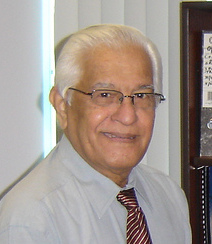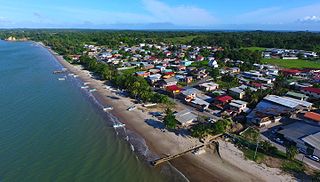
Trinidad and Tobago is an archipelagic republic in the southern Caribbean between the Caribbean Sea and the North Atlantic Ocean, northeast of Venezuela. They are southeasterly islands of the Lesser Antilles, Monos, Huevos, Gaspar Grande, Little Tobago, and St. Giles Island. Trinidad is 11 km (6.8 mi) off the northeast coast of Venezuela and 130 km (81 mi) south of the Grenadines. The island measures 4,768 km2 (1,841 sq mi) in area with an average length of 80 km (50 mi) and an average width of 59 km (37 mi). The island appears rectangular in shape with three projecting peninsular corners. Tobago is 30 km (19 mi) northeast of Trinidad and measures about 298 km2 (115 sq mi) in area, or 5.8% of the country's area, 41 km (25.5 mi) in length and 12 km (7.5 mi) at its greatest width. The island is cigar-shaped in appearance, with a northeast–southwest alignment.

Port of Spain (officially the City of Port of Spain, is the capital of Trinidad and Tobago and the third largest municipality, after Chaguanas and San Fernando. The city has a municipal population of 49,031, an urban population of 544,949 and a transient daily population of 250,000. It is located on the Gulf of Paria, on the northwest coast of the island of Trinidad and is part of a larger conurbation stretching from Chaguaramas in the west to Arima in the east with an estimated population of 600,000.

Tobago is an island and ward within the Republic of Trinidad and Tobago. It is located 35 kilometres (22 mi) northeast of the larger island of Trinidad and about 160 kilometres (99 mi) off the northeastern coast of Venezuela. It also lies to the southeast of Grenada.

Trinidad and Tobago has a unique history and its food is influenced by Indian-South Asian, West African, Creole, European, American, Chinese, Amerindian, and Latin American culinary styles. Trinidad and Tobagonian food is dominated by a wide selection of seafood dishes, most notably, curried crab and dumplings. Trinidad and Tobago is also known for its prepared provisions, such as dasheen, sweet potato, eddoe, cassava, yam, soups and stews, also known as blue food across the country. Corresponding to the Blue Food Day event held annually in Trinidad and Tobago.

Indo-Trinidadians and Tobagonians or Indian-Trinidadians and Tobagonians are people of Indian origin who are nationals of Trinidad and Tobago whose ancestors came from India and the wider subcontinent beginning in 1845.

Mayaro is the name of a county on southeastern Trinidad island, in Trinidad and Tobago.

Bhadase Sagan Maraj was a Trinidadian and Tobagonian politician, Hindu leader, civil rights activist, trade unionist, landowner, businessman, philanthropist, wrestler, and writer. He founded the Sanatan Dharma Maha Sabha in 1952, which grew to be the largest and most influential Hindu organization in Trinidad and Tobago and the wider Caribbean. He also founded the Caroni East Indian Association, the People's Democratic Party, the Democratic Labour Party, the Democratic Liberation Party, the Federation of Unions of Sugar Workers and Cane Farmers, and The Bomb newspaper.
The Sanatan Dharma Maha Sabha (SDMS), pronounced [sənɑːt̪ənə d̪ʰərmə məɦɑː səbʰɑː], colloquially known as the Maha Sabha, is the largest and most influential Hindu organization in Trinidad and Tobago. It operates 150 mandirs, over 50 schools, and has its own radio station, Radio Jaagriti 102.7 FM, and TV channel, TV Jaagriti. They also operate the Indian Caribbean Museum of Trinidad and Tobago. It was formed in 1952 when Bhadase Sagan Maraj engineered the merger of the Sanatan Dharma Association and the Sanatan Dharma Board of Control. An affiliated group, the Pundits' Parishad, has 200 affiliated pundits. The organisation's headquarters are located in St. Augustine.
The National Awards of Trinidad and Tobago consist of:

Diego Martin is a town and is the urban commercial center and capital of the Diego Martin region in Trinidad and Tobago. Its location in the region is just on the south eastern border, west of the capital city of Port of Spain and east of the town of Carenage. Diego Martin town in the Northern Range was once filled with a number of small valleys but is now a densely populated area. It was named after a Spanish explorer Don Diego Martín. The area was settled by French planters and their slaves in the 1780s. It consists of a cluster of communities including Congo Village, Diamond Vale, Green Hill, Patna Village, Petit Valley, Blue Range, La Puerta Avenue, Four Roads, Rich Plain, River Estate, Blue Basin, Water Wheel, West Moorings, Bagatelle and Sierra Leone.

Trinidad and Tobago are continental islands with a geologically very recent history of direct land bridge connection to South America. As a result, unlike most of the Caribbean Islands, Trinidad and Tobago supports a primarily South American flora and fauna and has greater diversity of plant and animal species than the Antilles. However, rates of endemism are lower than in the rest of the Caribbean because there has been less time for genetic isolation from mainland populations because of the history of land bridge connections and hence fewer opportunities for speciation, and so a greater proportion of the species in Trinidad and Tobago are also found on the South American mainland. Trinidad is nearer to mainland South America and has been directly connected to the mainland via land bridges more often and for longer periods than Tobago. This, as well as Trinidad's larger size and more varied topography and hydrology compared to that of Tobago allow greater species and ecosystem diversity on the former compared to that on the later of the islands.

Kamla Persad-Bissessar, often referred to by her initials KPB, is a Trinidadian and Tobagonian lawyer, politician and educator who is the Leader of the Opposition of Trinidad and Tobago, political leader of the United National Congress (UNC) political party, and was the sixth Prime Minister of Trinidad and Tobago from 26 May 2010 until 9 September 2015. She was the country's first female Prime Minister, Attorney General, and Leader of the Opposition, the first woman to chair the Commonwealth of Nations and the first woman of Indian origin to be a prime minister of a country outside of India and the wider subcontinent.

Basdeo Panday is a Trinidadian and Tobagonian lawyer, politician, trade unionist, economist, actor, and former civil servant who served as the fifth Prime Minister of Trinidad and Tobago from 1995 to 2001. He was the first person of Indian descent along with being the first Hindu to hold the office of Prime Minister of Trinidad and Tobago. He was first elected to Parliament in 1976 as the Member for Couva North, Panday served as Leader of the Opposition five times between 1976 and 2010 and was a founding member of the United Labour Front (ULF), the National Alliance for Reconstruction (NAR), and the United National Congress (UNC). He served as leader of the ULF and UNC, and was President General of the All Trinidad Sugar and General Workers' Trade Union.

Trinidad and Tobago, officially the Republic of Trinidad and Tobago, is the southernmost island country in the Caribbean. Consisting of the main islands Trinidad and Tobago and numerous much smaller islands, it is situated 11 kilometres off the coast of northeastern Venezuela and 130 kilometres south of Grenada. It shares maritime boundaries with Barbados to the east, Grenada to the northwest, Saint Vincent and the Grenadines to the north and Venezuela to the south and west. Trinidad and Tobago is generally considered to be part of the West Indies. The island country's capital is Port of Spain, while its largest and most populous city is San Fernando.

Cedros is a coastal area that lies on a peninsula at the South-Western end of the island of Trinidad. Named by Spanish sailors due to the once heavy presence of cedar trees, it is located at the tip of the peninsula which lies mere miles off the coast of Venezuela and is the most southern point in the Caribbean. The main area is known as Bonasse which is of French origin meaning "easy-going."
Sandhurst Tacama Miggins, is a fashion model best known as a contestant and first runner-up of the second season of the show Make Me a Supermodel.

Paramin is a village located on one of the highest points of western area of the Northern Range in Trinidad, Trinidad and Tobago, which forms part of the Maraval area. It is a sprawling, steep and mountainous village whose residents have traditionally been farmers, producing herbs like chives, thyme and parsley, as well as vegetables like tomatoes and yams.
Manzanilla Beach is a beach in Trinidad and Tobago. Located on the east coast of Trinidad, the larger island, the beach sits directly on the Manzanilla Bay adjoined to the larger north Atlantic Ocean.

The Hetton Colliery Lyon or Lyons is an early British steam locomotive that still survives in preservation. It is remarkable for having continued working into the early 20th century.
Trinidad and Tobago is the southernmost country of the West Indies; as of 2013, its adjusted maternal mortality rate is 84 deaths per 100 000 women; the rate is adjusted for underreporting and misclassification by the World Health Organization. The contraceptive rate, that is the percentage of women in union aged 15–49 years currently using contraception, is 42.5%. The fertility rate is 1.8 children per woman. Fourteen weeks of maternity leave with allowances is provided by the government; women typically choose to take this leave after the birth rather than before, to spend time with the newborn.
















